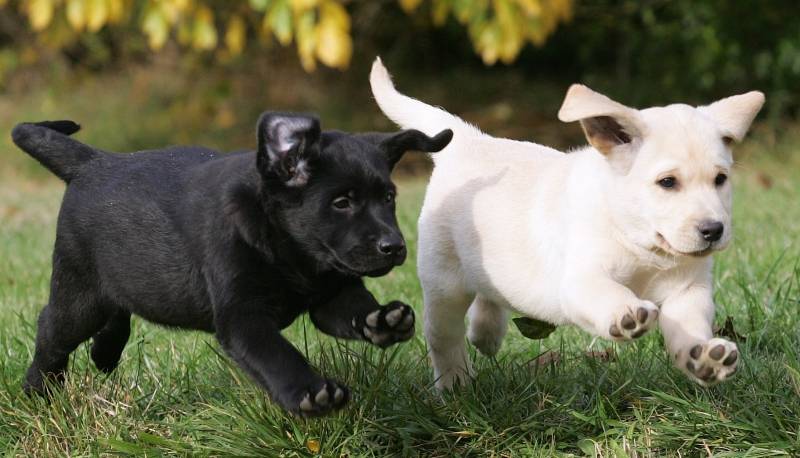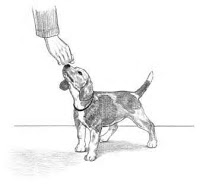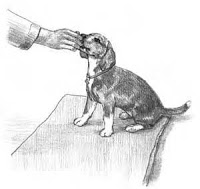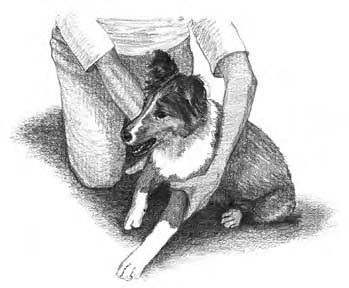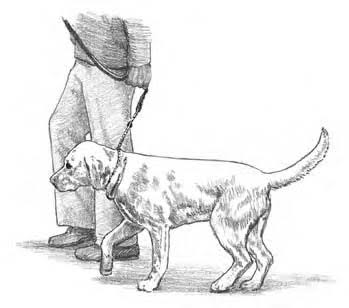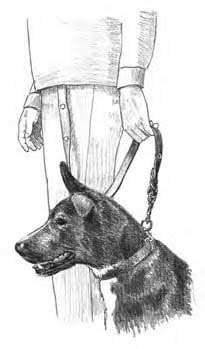In This Chapter
- Performing basic lessons with infant puppies
- Building on the basics with exercises for the terrible twos
- Training your adolescent pup
- Discovering what to focus on during puppy puberty
- Teaching the teen dog
Welcome to school. Puppy school that is! This chapter covers the basic directions that all puppies must learn to feel fully integrated and part of your world. Mutual understanding does more than create dogs who take orders — it fosters a communication bond that is equal to none.
Infant Lessons: 8 to 12 Weeks
Remember
Forget discipline at this stage because your pup is just too young to understand it. You succeed only in frightening him and eroding your relationship — and that’s not good.
Use your puppy’s name
Start leash training
Remember
Puppies grow fast, so keep an eye on the collar size and loosen it when necessary.
Work on “Sit” and “Okay”
Tip
Use the happy word “Okay” to give your puppy permission. Say “Okay” as you give your puppy positive things: a meal, pat, toy, and so on.
Walk the stairs
Tip
If you have a puppy with stair phobia, help him walk the stairs by cradling his belly and guiding his paws. If possible, have someone crouch down a few stairs away to cheer him on.
Work on handling and socialization
Handling
Tip
When you’re calmly petting your puppy, occasionally play veterinarian. Peek into your puppy’s ears and check out what’s going on in his mouth and eyes. Press his belly gently and handle the base of the tail. Handle the paws like you’re trimming his nails. So that he won’t get scared while you’re handling him, praise your puppy gently or give him a treat. By getting your pup used to being handled, you help yourself and your veterinarian, who always appreciates a good patient.
Socialization
Food and toy conditioning
Correct mischievous behavior
Tip
If your puppy is rough or jumpy during playtime, attach a short leash onto his collar. If he starts misbehaving, take the leash and tug him away from or off the person he’s jumping on. If you use your hands, the behavior may escalate because hands are considered interactive, and in your puppy’s mind, interaction is the best treat in the world.
Terrible Twos Lessons: 12 to 16 Weeks
Keep control
Remember
You’re still dealing with a young puppy. Keep yours near you in one of four ways:
– By using the leading and stationing concepts (outlined in Chapter Teaching Everyday Etiquette)
– By observing him in an enclosed area, such as a gated kitchen
– By keeping him in a crate
– By making sure he’s always with you around the home (Attach him to a dragging lead that’s attached to the buckle collar.)
Work on ten basic directions
Tip
Following are some suggestions when working with your toddler pup:
– Keep your lessons short and snappy. They should be no more than a couple of minutes.
– Speak your directions clearly and enunciate your syllables. Also, give directions only once because repeated directions sound drastically different from single directions (consider the indecipherable “sitsitsitcomeonpleasesitdown”).
– Continue using your directions during playtime.
– Use hand signals to help you get visual attention. Also use treats with some of the directions. However, after the direction is understood, food rewards should be phased out gradually to avoid treat dependence.
Look Up
Follow
Tip
This exercise is ideal for a clicker if you’re using one: Click when he cooperates, and then treat him. See Chapter Using Cool Tools and Groovy Gadgets for more on using this great training gadget.
Remember
The “Follow” direction isn’t optional. If your puppy doesn’t want to go and you stop to cajole him, you reinforce his resistance. Say the direction happily and then skip, bounce, or dart ahead — do whatever you can do to encourage his quick and willing participation.
Sit
1. Take your puppy aside with a handful of small treats.
2. Place a treat between your index finger and thumb and say “Sit” as you bring the treat slightly above your puppy’s nose (see Figure 14-1a).
3. When he sits, give him the treat, say “Okay,” and praise him (see Figure 14-1b).
Down
1. Take your puppy aside with some treats.
2. Placing the treats between your fingers, instruct “Sit.” However, before you let go of the treat, drop your hand between your puppy’s paws and say “Down.”
3. Your puppy may not know what to do, so as he looks down, press gently between his shoulder blades with your left thumb and press him gently into position (see Figure 14-2).
4. Let go of the treat when his elbows hit the floor, praise him, and say “Okay” to release.
5. Repeat Steps 2 through 4 five times.
Tip
Puppy pressure pointsIf you’re having trouble getting your puppy to do what you want him to do, there are several pressure points on your puppy’s body that, when gently pressed, will guide him into a specific position. Here are the ones I use most frequently for various commands:
|
Stand
1. Place a treat between your fingers and say “Stand” as you pull an imaginary string from your puppy’s nose forward.
2. When your puppy stands, stop your fingers and cradle his belly as you repeat “Stand.”
3. Pause and then release with “Okay” as you allow your puppy to have the treat.
Warning!
Your pup may try to snatch the treat early, but hold it firmly, say a discouraging “Ep, ep,” and don’t release it until he’s standing.
4. Repeat these steps five times.
Give
1. Kneel on the floor and praise your puppy happily for nearly a minute before you bring out the toy.
2. When you bring the toy out, toss it in the air (and catch it) to encourage his interest and then give it a short toss.
3. If he takes the toy, let him keep it for a while.
You want him to feel that you’re not there to challenge him for it.
4. Now bring out the treat (and clicker if you’re using it). As you offer your puppy the treat, he should spit out the toy. As he does, say “Give” and either click and treat or treat as you praise him.
5. Give the object back immediately.
This action will highlight your good intentions to play and not steal.
6. Continue Steps 2 and 3 until you notice that he looks to you as soon as he picks up the toy.
7. Encourage him to come toward you with the toy as you run away from him calling out “Bring.”
Tip
Your puppy should release the toy quickly, but if he doesn’t, you can encourage him by squeezing his upper muzzle just behind the canines. Praise him for releasing.
8. Repeat these steps five times and praise him profusely when the game is over.
Settle Down
Remember
In each room, your puppy should have a special corner or area equipped with a bed and a chew bone. Eventually, you want to be able to send your puppy to this area on direction — a tactic that is especially useful during human mealtimes or when you have company.
Warning!
Your puppy must be fully leash trained and older than 12 weeks before you secure him in order to avoid feelings of entrapment, which is common in young puppies. Before you begin teaching this direction, make sure you read and understand the stationing concept. See Chapter Teaching Everyday Etiquette for details.
Wait and Okay
Remember
The leader must always lead (that means you!).
Excuse Me
Continue to work on handling and socialization
Tip
Ask your veterinarian whether she can recommend a well-managed puppy kindergarten class in your town. Joining a class is a fun way to meet other puppies and people.
Remember
Lots of socialization doesn’t create a dog who won’t protect his home or his people. Socialization simply encourages your puppy to trust your judgment where people are concerned. On the other hand, lack of socialization creates a dog who is overly attached to his family and who is intolerant of visitors. Depending on his breed and temperament, this dog may become fearful or defensive of other people on or off your property. Such dogs are difficult to manage and are a constant concern around people. Spare yourself the agony and socialize that puppy.
Your Budding Adolescent: 16 to 24 Weeks
Remember
This process allows your puppy to be successful, mastering each direction before you start applying it to his day-to-day world — similar to letting children master their addition skills in school before asking them to balance your checkbook.
2 Gradually allow freedom around the house
Knowing the difference between praise and pettingWhen your puppy learns something new, it’s very exciting for everyone. But try to control yourself. When you get fired up, your puppy does, too. Learning takes a lot of concentration, which means that an excited pup won’t learn much. As you practice your exercises, remember that there’s a difference between praise and petting. Petting comes from your hand — it excites your puppy and communicates play intentions. Praise comes from your voice and eyes and is given from an upright position — it calms your puppy and communicates your leadership. Remember this handy phrase: “Praise between exercises; petting to end them.” |
2 Continue to teach manners
Remember
Give the “Sit” direction only once. If your pup looks at you as though you’ve never met or he simply ignores you, either tug the leash and say “No” or simply position him. Don’t get in the habit of repeating directions because he may never listen!
Add a word a week
Remember
As your puppy is developing, both physically and mentally, you need to start teaching these useful directions: Heel, No, Stay, Come, and Stand-Stay. If you work on the “word a week” plan, you’ll shape your puppy’s understanding and social skills in no time!
Heel
Do the simple circle
1. Relax your arms straight, keeping your left thumb behind the seam of your pants. Tug the leash back whenever your puppy pulls from your side.
2. Instruct your puppy by saying “<Name>, Heel” as you begin to walk in a counterclockwise (dog on the inside) circle.
Walk in a cheerful manner, with your head held high and your shoulders back to communicate the right attitude.
3. Praise your puppy for walking with you.
If you want to, introduce a click or a treat for his cooperation. Tug him back into position if your puppy’s attention starts to stray.
4. Stop after each circle by slowing your pace and reminding him to “Heel.”
5. Place your puppy into a sitting position.
Tip
To position your pup into the sit position when you stop, grasp the base of the leash (where the leash attaches to your puppy’s collar) with your right hand and use your left hand to squeeze the pressure point located on his waist.
6. Practice five circles twice a day.
Warning!
If your dog turns to face you when you stop, guess what? He’s facing off. He’s making another attempt at interaction, play, and misdirection. To discourage this habit, either hold his waist into position as you stop or come to a stop alongside a wall or barrier so that he’s unable to move out of position.
Float the finish
Tip
When you’re preparing to stop, slow your pace slightly, lift your left foot high in the air (like you’re marching), and then drop it lightly to the floor. This action gives your puppy an added clue that he’s supposed to stop and sit.
Change your pace
Do an about face
Heeling practice tips
– Keep a short lead on your puppy around the home. Pick the lead up occasionally and say “Heel” as you walk from room to room.
– Use the “Heel” direction on your walks. If your puppy’s young or just beginning to learn, heel him for one-fourth of your walk. Increase the distance over the next month until your puppy is always walking at your side.
– Practice heeling in a parking lot and other more crowded situations (just make sure they’re not too crowded). Don’t allow sniffing or lunging at neighborhood pals and be mindful of your puppy, no matter what the distractions.
Warning!
Stay calm if things get out of hand when you’re in public. If you yell “Heel, heel, heel!” and jerk your poor puppy back and forth, he’ll just get more excited. If you have this problem, determine whether you’re asking too much too soon. Maybe your puppy simply needs to exercise more before you practice in public.
Remember
Be sure to keep your hand behind you — left arm straight and behind your back (see Figure 14-4). If your left hand is in front of your thigh, your puppy is the leader, not you.
Tip
Is your puppy too strong for you to manage? Try the tush push, which transfers the strain of your leash from your arms to the trunk of your body. Here’s how it goes: Slide the leash around your backside and grasp it in both hands. Slide both thumbs together and rest them on your left tush. Keep your arms straight and relaxed, and when your puppy surges ahead, simply push back with your tush.
No
– People usually shout it. Shouting to a puppy sounds like barking. Would barking excite a situation or calm it down?
– People use it with their puppies’ names. (In fact, many puppies think No is the second half of their name: “Buddy No!” “Tristan No!” “Molly No!”) You should only use your puppy’s name when you’re happy, not mad.
– People say it after the action has occurred. If I yelled at you after you ate a bowl of soup, would you understand that I was upset at you for opening the can? Said at the wrong time, “No” communicates nothing.
– People say it repetitively. “No, no, no, no” sounds different from “No.”
1. Bring your puppy into the heel position and casually walk toward the cheese.
2. The second your puppy notices the cheese, tug back on the lead and say “No!”
Tip
Your puppy has a built-in antenna system: his ears. If his ears perk up, your puppy is alert. When teaching No, watch your puppy’s ears. Correct your puppy the second he becomes alert to something inappropriate.
3. Continue to walk like nothing has happened.
Remember: You’re the boss. No means No.
4. Walk by the cheese several times to ensure that your puppy got the message.
Tip
If you’ve been using “Ep, ep” with your puppy, save “No” for major infractions like stealing food from the counter or chasing the cats or kids. You may continue to use “Ep, ep” if you catch your puppy going astray, like when he’s sniffing something on the street or considering mischief.
Stay
Remember
Here are a few rules to follow when teaching the “Stay” direction:
– Look over your puppy’s head when you practice; never look directly into his eyes. It’s too daunting for him.
– Stand tall. When you bend down, you look like you want to play.
– Stay close to your puppy when you start out. You should have about 6 inches from toe to paw. Creating too much distance too soon can be really scary for your pup.
– While doing each exercise, hold the lead directly above your puppy’s head. That way, if he confuses “Stay” with “Go,” you’re ready for a quick correction.
– When you return to your puppy’s side at the end of each exercise, vary the length you pause before you release him with “Okay!” This will prevent his “reading” the pattern and encourage a more watchful eye on your direction.
– Resist petting your puppy until you finish teaching him the steps for the “Stay” direction. Too much petting ruins his concentration.
1. Take your puppy into a quiet room.
No TV. No kids. No cats. Just you two.
2. Slide your puppy’s training collar high near his head and center it between his ears.
3. Fold the leash in your left hand to hip level.
4. Position your puppy behind your heels.
1. Instruct “Sit” and align your puppy with your ankles.
2. Instruct “Stay” as you flash your hand in front of your puppy’s nose. Remove the hand signal and pause for five seconds.
3. Instruct “Okay” as you swing your arm forward and step out of position.
4. Again, instruct “Sit, Stay.” This time, pivot to face away from your puppy and pause ten seconds. Return to the starting point and release with “Okay!”
5. Back to the start position again. Instruct “Stay.” Pivot in front of your puppy. Pause. Now march to create a physical distraction that will teach your puppy how to contain himself.
Yes, I said march! March slowly at first, like you’re sleepwalking. After your puppy holds still for that, gradually increase your physical motions.
6. Instruct “Stay” and pivot and pause. Now try jumping and waving your arms.
Go slowly at first. You want to ease into your mania. Now make some noise.
7. Pivot, pause, and then bark at your puppy. Then return, pause, and release.
Remember
No staring into your puppy’s eyes. Instead, keep looking over his head. Add a meow or two when you think he can handle it.
8. From your starting position, instruct “Stay,” pivot in front, and pause for 30 seconds.
Stand up tall, relax your shoulders, and keep the leash above your puppy’s head just in case he’s tempted to break.
9. When the time is up, return to his side, pause, and release with “Okay!”
10. Now you can hug that well-behaved puppy!
Remember
Some puppies have a reduced attention span and initially may not be able to hold still for long. Check to ensure you’re following protocol: Are you standing right in front of him as you increase distractions? Are you holding the leash above his head to enforce his control? Are you introducing this direction in a discrete location? Too many distractions make it impossible to concentrate.
– Distraction: Step up your march, add a new aerobics twist, walk around your puppy full circle, and chant like a chimp. Can you do all these crazy things without tempting your puppy to move?
Are you wondering why you’re jumping around and making noise while your puppy’s expected to stay? Eventually, your puppy will have to concentrate while confronted with motion and sound distractions, so you’re helping him get accustomed to temptations.
– Duration: Stretch your 30-second stand-still to two minutes.
– Distance: Move out one foot at a time. When you’re successful, reintroduce distractions gradually and increase the duration.
Hand signals can help your puppy focusYour puppy can start learning hand signals as early at 12 weeks of age, although I recommend emphasizing signals at 4 months. This visual direction will intensify your puppy’s focus — and as you know, if he’s taught to watch you he’ll not stray far. Use hand signals in front of your puppy’s nose to direct his attention to you. Review the point training lesson in Chapter Using Cool Tools and Groovy Gadgets, and then use the point to signal your directions. Here’s my list:
|
Come
Going for up-close control first
Remember
The goal when you say “Come” is to have your puppy return and make contact with you. Each time you say this direction, pat, treat, or otherwise handle your puppy so that he learns that “Come” means “togetherness and interaction.” To teach your puppy how to come from short distances, follow these steps:
1. Walk in front of your puppy while he’s standing calmly.
2. Standing tall, say “<Name>, Come” as you zip your finger up your belly from his nose level to your eyes.
Tip
Make a funny sound to encourage focus: Cluck, whistle, smooch, or make up your own!
3. If he doesn’t look up, cradle his body into a sitting position and pat the sides of his head lovingly. “Come” should be associated with a warm and loving reconnection.
To position your pooch, lift up on his buckle collar and tuck his hindquarters into position, squeezing his waist muscles below his ribs as you press down.
Warning!
Avoid jerky motions, don’t press his backbone, and don’t admonish him or repeat yourself as you position. Doing so causes “Come” to be associated with rough handling.
4. After your puppy makes eye contact, give him a big hug or pat on the head.
Going for distance control
Tip
Practice this exercise in a quiet room and keep your lesson short and upbeat. To teach distance control, make sure your pup is wearing a leash and then follow these steps:
1. Practice three regular Sit-Stays and then return to your puppy’s side and release him with “Okay!”
2. Leave your puppy in a stay position and walk to the end of the leash.
3. Pause. (Vary the duration each time.)
4. Call “<Name>, Come!” in a directional tone. Signal it by sweeping your right arm across your body.
5. As soon as you issue the direction, scurry backward and reel in the leash.
6. When your pup gets near your feet, zip your finger up your belly from his nose level to your eyes and tap your heel to the floor to encourage him to stop and look up.
7. Encourage eye contact by standing or kneeling and making kissing sounds.
8. Release him with an “Okay,” and always remember to praise the good puppy.
Tip
Practice “Come” three times per session. That’s all. More than that is stressful for your pup.
Building focus by throwing in distractions
Remember
Using the “Come” direction around distractions is more difficult than using the direction in a quiet living room. Most dogs try to pay attention to the distraction and you at the same time, which is impossible. If your puppy’s torn, tug the leash and use praise or a treat cup to focus him.
1. Let him sniff about while letting the leash drag behind him.
2. Pause varying lengths of time before you call him.
3. Relax your posture and say “<Name>, Come!”
4. Flag him in.
5. Encourage him to sit or lean into you for a hug.
6. If you’re using food or a click-treat combination, reward him the moment you touch.
Remember
You’re not in a rush. Training your puppy isn’t a race. And whatever you do, don’t get frustrated. Frustration kills enthusiasm.
– When your puppy’s distracted on a walk, during regular teaching, or on a retractable leash.
– Additionally, you can run away from your puppy throughout the day to encourage him to check in with you by using your treat cup or a clickand-treat combination to highlight your reconnection.
“Come” do’s and don’ts
– Do use it sparingly. When you overuse “Come,” dogs stop paying attention.
Tip
When your puppy understands the direction, avoid using it all the time. Say it infrequently and make it extremely rewarding. (Don’t forget about the other directions you have in your arsenal: “Inside” for coming indoors, “Let’s Go” for follow me, and “Heel” for staying at your side.)
– Don’t chase your puppy if he doesn’t respond. Practice on-lead for now or use a long line to give him more freedom to explore.
– Don’t call for negative interaction. Do you have to brush, bathe, or isolate your puppy? If so, don’t use “Come.” Also avoid using it when you’re angry. You’ll only freak your puppy out.
– If your puppy runs away, don’t repeatedly call or correct him. I know the frustration of marching around in the middle of a cold, wet, rainy night looking for your puppy, but if you call or discipline your puppy, you’re only teaching him to run from you. If your puppy does run off, here are some measures you may take:
- Call the police as well as neighbors.
- If you can see your puppy, block roads to prevent a mishap.
- Overexaggerate playing with a stick or digging a hole. Stay focused on the activity so your puppy will be intrigued. Calmly reach for him only after he has returned to your side.
- If you’ve practiced the games listed in Chapter Ten Fun Games, find some props (or carry them with you) to initiate a game to highlight your fun. Your puppy won’t be able to resist.
– Don’t discipline your puppy when he returns to you. He won’t come back so quickly the next time.
– Do use a different direction to bring your puppy inside. Coming in from outdoors is a big drag for your pup, no more fun than being left alone or ignored. Using the “Come” direction when you want to bring your pup inside makes it a negative direction. Instead, pick a direction like “Inside.” Start using it on-lead when bringing your puppy into the house. Quickly offer a treat or ball toss.
Stand-Stay
1. Kneel down on the floor next to your puppy.
2. Place your right hand, palm out, on your puppy’s buckle collar.
3. Slide your left hand under your puppy’s belly.
4. Say “Stand-Stay” as you prop your puppy into a standing position.
5. Relax your right hand and slide your left hand so that it rests on your puppy’s thigh.
6. Vary the pause from two to five seconds — and release with an “Okay!”
7. Increase the pause time to one minute.
8. Repeat Steps 2–7 from a standing position.
After your dog’s standing still, you’re ready to let go.
9. Prop your puppy into position.
10. Remind “Stay,” and slide your left hand away from your puppy.
11. After you’re successful, slide your right hand from the collar.
Remind “Stay” as often as necessary.
Tip
When introducing this direction for grooming, use peanut butter or another creamy spread slathered on the refrigerator at his nose level. Grooming will be quite the treat for your pup. Eventually, his association will be set, and he’ll look forward to grooming activities with or without treats!
Puppy Puberty Lessons: 6 to 9 Months
– Remain calm. Don’t let your puppy see that you’re angry or frustrated. All teens, regardless of species, derive perverse pleasure out of your discomfort.
– Don’t let your puppy ignore you. If your puppy challenges you on a direction and he’s on leash, reinforce your expectations. If your puppy is off-leash and he ignores or defies a direction, ignore him and withdraw from the situation.
Remember
A graceful retreat isn’t a failure.
– Raise his consciousness. Teach or remind him of the meaning of “No.” See the section “No,” earlier in this chapter, for details.
Talking to your pubescent puppy
– Detach. Detaching is more a meditation exercise than a dog-training technique. Basically, this technique is for your own benefit, although your mental calmness will affect your puppy too. You appear more centered, and who wouldn’t respect that! Breathe in and breathe out and detach yourself from your puppy. Avoid taking his behavior personally. Although you may think all your training has been a waste of time, it hasn’t. Remember this: Puppyhood equals patience plus persistence.
– Stay centered. When your puppy is acting up, use all your energy to stay cool. If you get angry or tense, he knows he’s got to you. At that point, you’re playing his game and following his lead.
– Watch out for eye contact. Puppies are very concerned with status at this age: “Am I a leader or follower?”
Remember
If your puppy can get you to look to him more than you can get him to look to you, you’re the follower. Ignore your puppy’s attempts to get your attention. Pet and gaze at him when he’s in a calm state of mind. Give him eye contact when you direct his behavior.
– Fall back, if necessary. Even if you’ve successfully weaned your puppy from the leash, you’ll probably need it again during this stage. When your puppy is overstimulated and unable to focus, connect him to your side or station him for a while with a bone.
– Have alternative plans. During behavior emergencies — for example, out-of-control door greetings, article stealing, running away, and so forth — use your directions, if they work. Most dogs, however, become temporarily deaf during these situations, so have alternative plans. See the upcoming section “Handling common problems” for alternatives.
Handling common problems
Door greeting
Article stealing
Runaway puppy
– Try a direction or two. If they don’t work, stop. Don’t panic.
– Try running around like a lunatic (without eye contact), screaming and waving your arms. Drop to the ground in a heap and see whether this strange and interesting behavior brings him running.
– Try getting in the car. Many dogs can’t bear the thought of missing out on a trip.
– If nothing works, follow him quietly to make sure he stays out of danger. Yelling only makes matters worse. Stop traffic if you can, and ask for help if you need it.
Warning!
Avoid getting angry at your puppy after the fact. Otherwise, he’ll learn to be more wary of your ploys. Never use treats as bribery because when used in this way, treats actually reinforce mischief.
The top five directions
Handling walks with “Heel”
1. Place him on a leash and let him walk ahead of you.
2. Suddenly call his name and the direction “Heel” as you slap your left thigh.
3. Take a giant step backward as you lead him back to your side as you reel in the leash.
Lead him around your left side in a U or to your right around your back. When he reaches your side, make sure he sits before you release him.
Tip
After he gets the hang of the “Heel” direction (thigh-slap), begin to encourage him to come to your side around distractions (on-leash at first) and when you’re sitting down. Always give the direction positively, enforce a proper sit, and praise him warmly before you release him with “Okay.”
Reinforcing manners with “Sit”
Using “Down” in all kinds of situations
Tip
When your puppy begins cooperating, use “Down” for everything, such as before treating (hold the treat to the ground and direct “Down”) and before dinner (cover the bowl with your hand and, as you put it down, say “Down”).
Practicing “Wait” with more distractions
1. Stop in your tracks as you direct “Wait.”
2. Pull back on the leash if your pup doesn’t stop with you.
3. Release with “Okay.”
Taking “No” outside
Trying Teen Lessons: 9 to 12 Months
Remember
To develop the all-important canine consciousness, you must do two things:
– Decide what you want when you give a direction.
– Follow through. If your expectations are unclear, your puppy’s reaction will be, too.
Remember
If your puppy pivots out of position when you stop in “Heel,” inches forward on the “Stay” directions, or moves in front of you during stationary directions, he’s testing you. If you position him sweetly, you’re actually giving him attention for his defiance. In these situations, tug the leash firmly as you say “No” and position him by maneuvering him into place with the leash. This method may take several tries and a temper tantrum from your beloved pet, but if you let the structure slide, you’ll never have a reliable off-leash dog. (Refer to Chapter Graduating to Off-Lead Control for info on training off the leash.)
Sarah Hodgson





